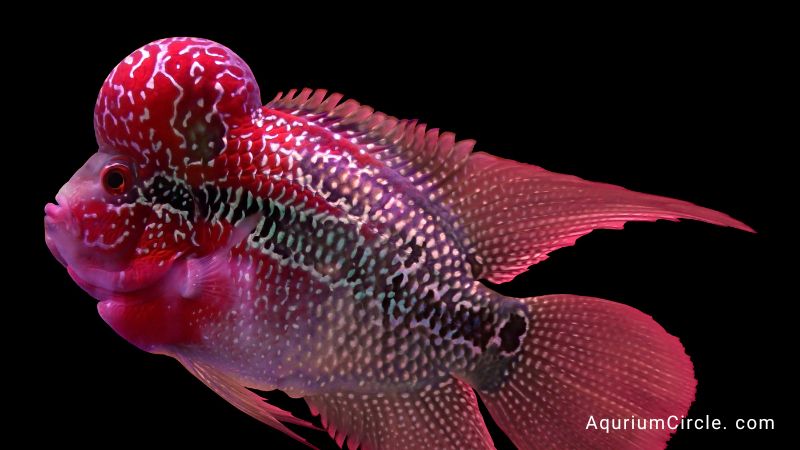Popular freshwater fish typically kept in aquariums are called African cichlids. There are many different kinds of African cichlids, and each one has its own distinctive traits and upkeep needs. The variety of African cichlid types, as well as their physical characteristics, natural habitats, and the best methods for taking care of them in your home aquarium, will all be covered in this article.
How Many African Cichlids Types?
African cichlids come in a wide variety, with estimates of the number of species ranging from 1,000 to over 3,000. African rift lakes, such as Lake Malawi, Lake Tanganyika, and Lake Victoria, are home to a variety of fish species known as African cichlids. Because of their distinctive personalities and mannerisms, they are well-liked among aquarium hobbyists and come in a wide variety of colors and patterns.
African cichlids come in a variety of well-known and well-liked varieties, including Mbuna, Peacock, Haplochromis, and Tropheus. These fish are both fascinating and difficult to raise because each type has its own unique traits and maintenance needs.
What Things Should You Consider When To Choose Cichlids?
Tank size and water quality are the first considerations when looking through the diversity of cichlid species to select a home aquarium. This will change depending on the fish’s place of origin or natural habitat. Following the determination of your tank and water requirements, consider the following additional factors.
- Most cichlids enjoy digging: A sandy substrate is, therefore, the ideal choice to keep them safe from harm. Most animals don’t eat living plants. However, some may uproot them when digging.
- African cichlids have strong territorial instincts: The cichlids can stake out territory using cave formations, driftwood, or rockwork. Moreover, decorations disperse the line of sight to lessen hostility.
- They require a balanced diet: Find out if your cichlid is a herbivore, omnivore, carnivore, or piscivore by doing some research.
- Don’t feed them too much: Cichlids eat whenever they can. If given a chance, they will consume everything that you put in the tank. So, ensure that everyone is eating the appropriate amount of food.
- They eat in a sloppy manner: With these fish, they set up rigid routines for cleaning and maintaining the water. It’s typical advice for cichlid care to recommend a sturdy filter and weekly water changes.
Some African Cichlids Types
The complex collection of fish known as African cichlids is indigenous to the Great Lakes of Africa, which include Lake Malawi, Lake Tanganyika, and Lake Victoria. They are a popular option for aquarium hobbyists because of their wide variety of colors, sizes, and patterns. The Mbuna, Peacock, Haplochromis, Frontosa, and Tropheus cichlid species are some of the most popular varieties of African cichlids. African cichlid species differ from one another in terms of coloration, behavior, and environmental preferences.
Kribensis cichlids
The Kribensis, one of the calm cichlid species, is vivacious and gregarious in a community tank.
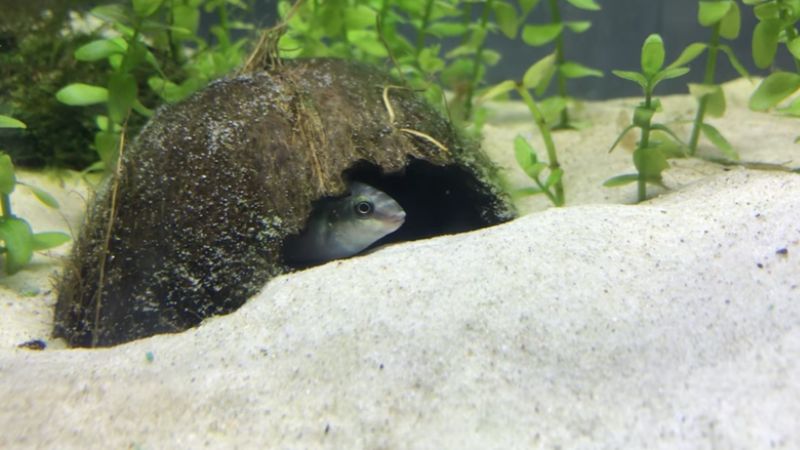
These fish come from the freshwater coastal regions of Nigeria and Cameroon, though many of the specimens you will find for sale have been captivity grown. The maximum size for this Kribensis cichlid is three inches (7.6 cm) for females and four inches (10 cm) for males. Their bellies are a vibrant grey color, and they have an upswept dorsal fin and tail.
Although this species gets along well with its tankmates, it is very protective of the cave it has chosen, especially when spawning. Keep them apart from other species that live in caves.
Jewel cichlids
African lakes Lake Malawi and Lake Tanganyika are the natural habitat of the jewel cichlid, a species of an African cichlid. They are well-liked among fish fans due to their eye-catching hues and patterns. The western freshwaters of Africa are home to the active species known as the jewel cichlid. The most popular color option is a gorgeous red/orange body with turquoise dot accents. There is also a blue version available.
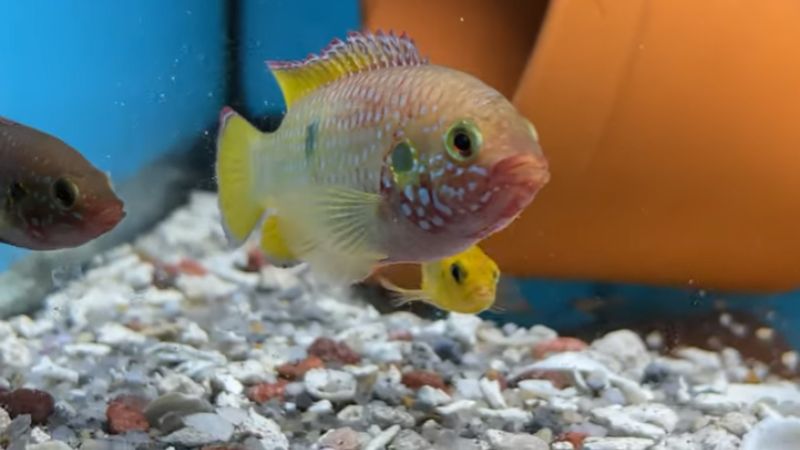
Jewel cichlids may be kept in aquariums of all sizes and require only minimal maintenance. Also, they have a reputation for acting aggressively. Therefore, it’s crucial to keep them with fish species that can put up with their disposition. Jewel cichlids may survive in captivity and add greatly to any aquarium with the right care and conditions.
This fish can grow to a length of six inches (15 cm) in captivity.
Managing the aggression of the gem cichlids is difficult. They will experience a great deal of stress, have a higher likelihood of becoming aggressive, and die sooner if you put them in an aquarium that is too small or lacks rocky regions they can claim. Consider using them in a single-species tank and feeding them well to lessen their propensity to fin nip.
Frontosa cichlids
Popular African cichlids called Frontosa cichlids are native to Lake Tanganyika in Africa and are also known by the scientific name Cyphotilapia Frontosa. With a tall, elongated bodies, big fins, and recognizable blue and black stripes on their face and body, they are renowned for their remarkable look. Frontosa cichlids can be kept in groups and are typically calm, but it’s crucial to give them a tank that’s big enough for their size and swimming style. They can be given a range of meals, such as pellets, flakes, frozen foods, and live foods, because they are omnivores. Because of their distinctive appearance and calm temperament, Frontosa cichlids are a favorite among aquarium hobbyists.
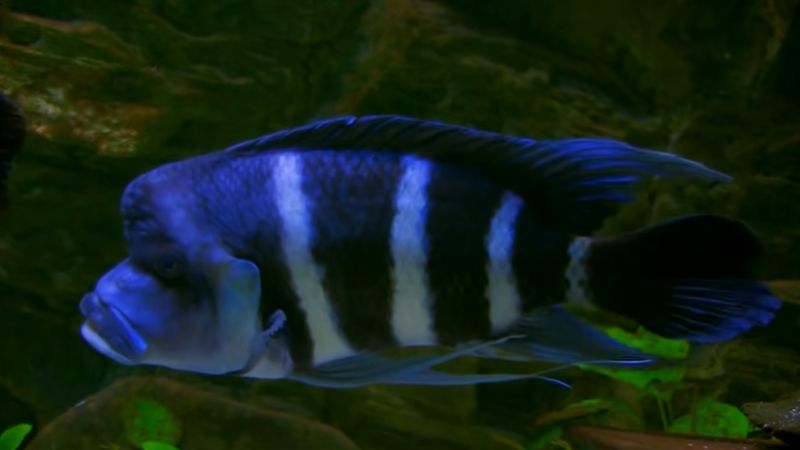
The Frontosa cichlid has an unusual morphology with a prominent hump on its forehead that deepens with age. They have light blue or white stripes alternating with bold black stripes. Their anal and dorsal fins gently sweep back to a point. All aquarium species are captive-bred, with the exception of Frontosas, which are only found in Lake Tanganyika in Africa.
Frontosas have engaging personalities and will interact with their owner in a lovable way. The dominant male will develop the biggest hump in a group of these fish, which can be kept together and will establish a hierarchy. These are a big species, with adults measuring just under 14 inches (35 cm) long.
Demasoni cichlids
Popular and eye-catching Demasoni cichlids are an African cichlid fish species. Its striking blue and black striped pattern makes them a native of Lake Malawi in Africa. Demasoni cichlids are notorious for their aggressive behavior toward other fish, especially those of similar size and color. They are rather little, only reaching a maximum length of approximately 3 inches. To reduce violence, it is ideal for keeping them in sizable groups with lots of hiding places. Although having a tendency to be violent, Demasoni cichlids are a favorite among aquarium hobbyists because of their eye-catching beauty and unique behavior.
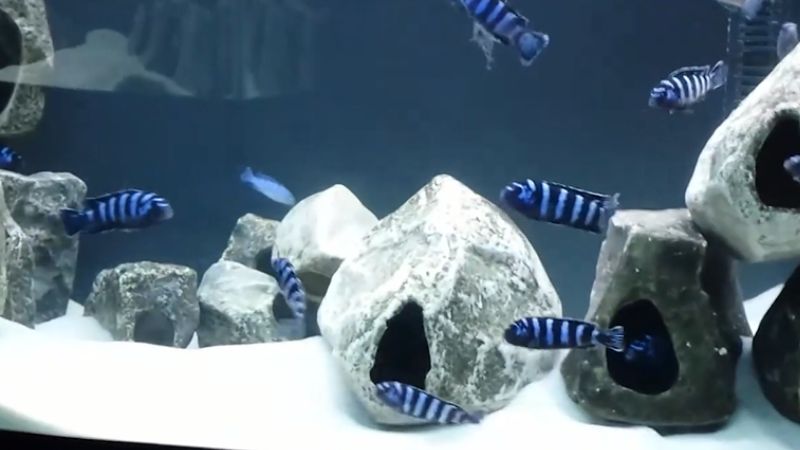
Venustus cichlids
A well-liked type of African cichlid that comes from Lake Malawi in East Africa is called a giraffe cichlid, sometimes known as a Venustus cichlid. They are renowned for their distinctive coloring, with males having stripes of vivid blue and yellow and females having more muted hues.
Medium-sized Venustus cichlids can grow up to 8 inches in length and have a captivity lifespan of up to 10 years. When fully mature, these huge fish can be up to 10 inches (25 cm) long and need a diet high in fish or meat. Cichlids are generally calm, but during breeding season or if their area is in danger, they may turn hostile toward other fish. Venustus cichlids need a large aquarium with many hiding spots and a rocky substrate to replicate their natural habitat. They should be given a variety of high-quality flakes, pellets, and live or frozen foods because they are omnivores.
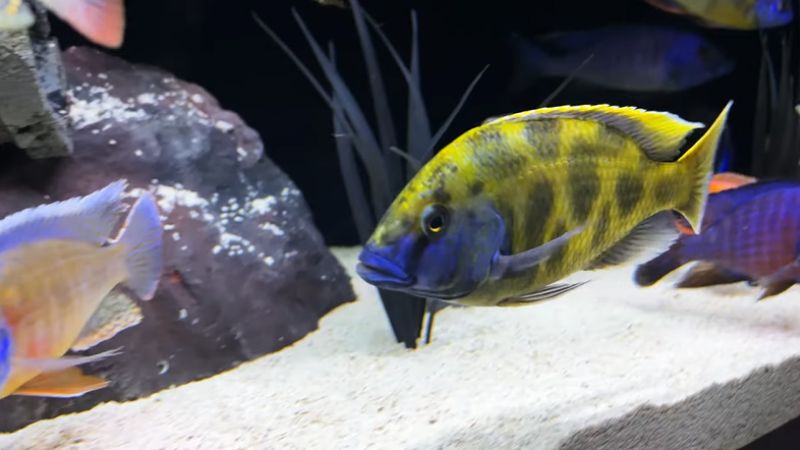
There’s a good reason why the Venustus cichlid is often referred to as the giraffe fish. Their gold/beige patterns immediately invoke the memory of their namesake. As they get older, males get a blue tint around their heads, while females get a darker “giraffe” pattern. Venustus are unexpected predators that hide in the substrate and wait for their victim to approach them.
While their temperament is ideal for a community tank and their preferred prey are smaller fish, do not couple Venustus with small species. Only keep one male in the tank and no tank mate.
Electric blue cichlids
African cichlids of the electric blue kind, commonly referred to as electric blue haps, are a species that are native to Lake Malawi in East Africa. They are renowned for having a dazzling blue hue, as their name would imply, and aquarium hobbyists prize them highly. Compared to other African cichlid species, electric blue cichlids are rather calm, although they can still be territorial and show aggressive behavior toward other fish in the tank. They can be fed a range of diets, including pellets, flakes, frozen, or live items, because they are omnivorous. They typically reach a length of 5 to 6 inches and, given the right care, can live for 8 to 10 years.
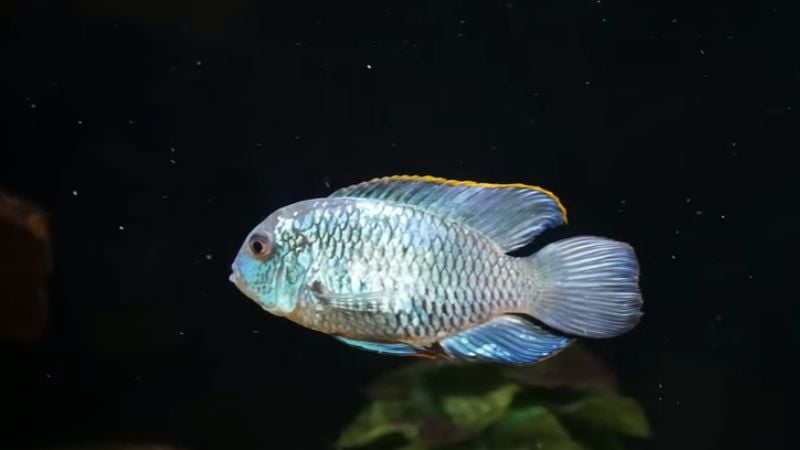
This omnivore favors are easy to care like meaty foods, such as bloodworms, brine shrimp, and even smaller fish. Avoid pairing them with smaller species it may view as food, and consider breeding your own feeder fish to satisfy your electric blue’s needs. Keep only one male in your tank to avoid hierarchical and territorial aggressive fish behaviors.
Lionhead cichlids
The lion head cichlid’s peculiar swimming style could startle you when you first examine it. This fish, which is native to swift-moving streams, skims the substrate as a means of energy conservation. A champion swimmer is not produced by this habit or its smaller swim bladder.
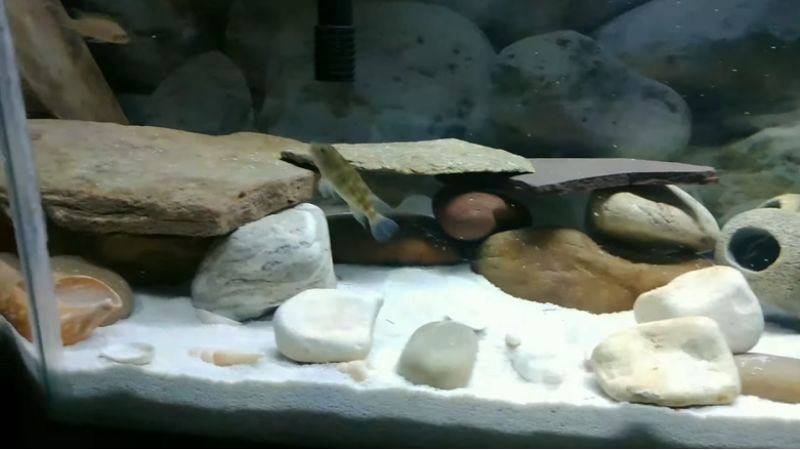
The males of this species develop to a maximum length of 4.5 inches (11 cm), whereas the females are just two inches (5 cm) long at maturity.
Kenyi cichlids
Popular African cichlids called Kenyi cichlids come from Lake Malawi in East Africa. They are distinguished by their vivid yellow coloring, and mature males have horizontal blue and black stripes on their bodies. Kenyi cichlids are typically quite small, growing to a maximum length of about 4-5 inches. They do best when housed in a tank with only members of their own species or with other Lake Malawi cichlids of a similar size and temperament.
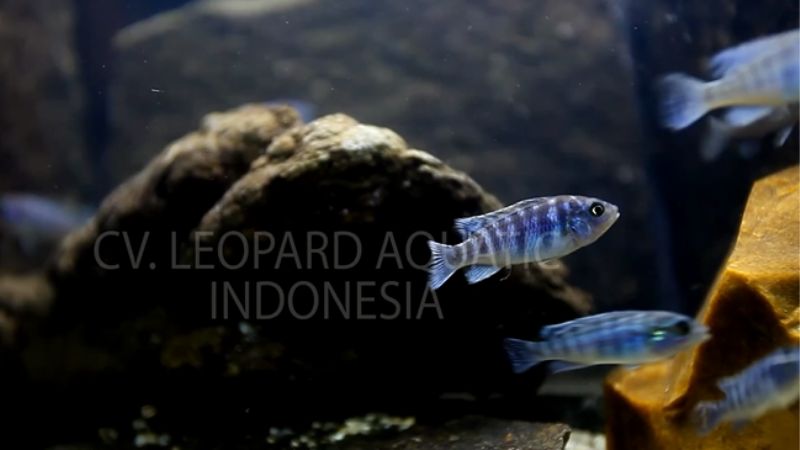
Kenyi cichlids are territorial and active fish. Thus, they need a nicely decorated aquarium with lots of hiding places so they can claim their own territory. They should be fed a wide fish food diet that contains both plant and animal stuff because they are omnivorous.
Red empress cichlids
Protomelas Taeniolatus, often known as the red empress cichlid, is a well-known African cichlid species that is indigenous to Lake Malawi in Africa. In comparison to other cichlid species, they are small, peaceful fish that are well-known for their vibrant coloring.
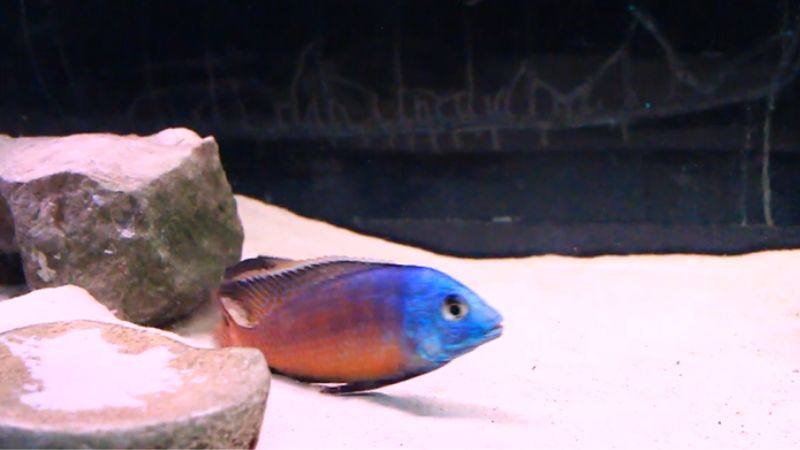
Female red empress cichlids are typically brown or tan in appearance, while males have vivid red coloring with blue accents. Red emperor cichlids are a preferred option for many fish keepers since they are well renowned for being simple to maintain and reproduce in home aquariums. They can be housed with other peaceful cichlid species and like a large tank with lots of hiding places.
Others
- Acei cichlids
- Red zebra cichlids
- Ob cichlids
- Blue dolphin cichlids
- Sokolofi cichlids
- Snow white cichlids
- Strawberry cichlids
- Duboisi cichlids
- Golden mbuna cichlids
- Star sapphire cichlids
- Livingston cichlids
- Fairy cichlids
- Blue peacock cichlids
- Sunshine peacock cichlids
- Shell dwelling cichlids
- Johanni cichlids
- Maingano cichlids
- Albino cichlids
- Dragon blood cichlids
- Emperor cichlids
- Tropheus cichlids
- Calvus cichlids
- Flameback cichlids
- Buffalo head cichlids
- Leleupi cichlids
- Daffodil cichlids
- Rusty cichlids
- Starry night cichlids
- Taiwan cichlids
- Definition cichlids
- Lake malawi cichlids
- Lake victoria cichlids
- Lake tanganyika cichlids
- Taiwan reef cichlids
- African cichlids
- Yellow lab cichlids
- Peacock cichlids
- Bumblebee cichlids
- Saulosi cichlids
- Auratus cichlids
- Multies cichlids
- Dogtooth cichlids
- Electric yellow cichlids
- Malawi cichlids
- Butterfly peacock cichlids
- Flavescent cichlids
- Blue daktari cichlids
- Blue neon cichlids
- Convict julie cichlids
- Lemon cichlids
- Masked julie cichlids
- Sardine cichlids
- White pearly calvus cichlids
- Spotfin goby cichlids
- Flowerhorn cichlids
- Heckel dicus cichlids
- Blood parrot cichlids
- Black belt cichlids
- Firemouth cichlids
- Green terror cichlids
- Golden severum cichlids
- Jack dempsey fish cichlids
- Oscar cichlids
- Pearl cichlids
- Red devil cichlids
- Redhump cichlids
- Cocktatoo cichlids
- Panda dwarf cichlids
- Rainbow cichlids
What Fish That African Cichlids Can Breed With?
Because they vary genetically from other fish species, African cichlids can only mate with other African cichlids. Unfortunately, due to variations in their natural habitats and water characteristics, not all African cichlids can reproduce with one another. Before attempting to breed your African cichlids, it is crucial to do your homework on the species’ compatibility with other fish.
FAQs
Are African cichlids hard to keep?
African cichlids have unique care needs that can make keeping them a little difficult. They come in a number of varieties, each with specific care requirements, and require steady water conditions as well as a clean aquarium. African cichlids are also known for their aggressive and territorial temperament, so it’s crucial to pick your tank mates wisely and to give them lots of hiding spots and territories. Yet, many enthusiasts discover that African cichlids are gratifying and fascinating fish to keep with the right knowledge and care.
Should beginners choose African cichlids?
No. African cichlids are typically not suggested for beginners due to their unique water requirements and potential for aggression. To ensure success, a newcomer who is interested in maintaining African cichlids should thoroughly investigate the species they intend to keep and the care they will need. To accommodate several fish and preserve optimum water quality, it’s crucial to start with a larger tank.
African cichlids lifespan
Depending on the species, African cichlids can live anywhere between five and ten years in captivity. Several species can survive up to 20 years or longer if their aquarium is properly cared for and maintained.
References:
- Wikipedia – https://en.wikipedia.org/wiki/Cichlid
- List – https://en.wikipedia.org/wiki/List_of_cichlid_fish_of_Africa

Annette M. Chaney is an experienced marine biologist with over 20 years of experience as an aquarist and fishkeeper. She started her first aquarium at a young age, filling it with frogs and goldfish obtained from the ten-cent pet store.
Annette grew up caring for and breeding African Cichlids, which led to a hobby in high school that doubled as a profitable means. Attending Reed College gave her time to solidify herself as an accomplished aquarium caretaker with an eye for sales. After that, from 2009 – 2013, she studied at Roger Williams University – one of the most prestigious universities for Aquaculture and Aquarium in USA. She is the founder of AquariumCircle since 2010.
